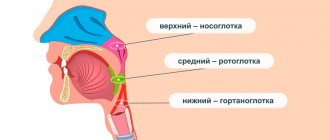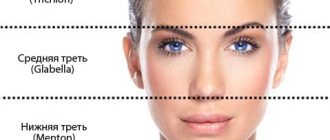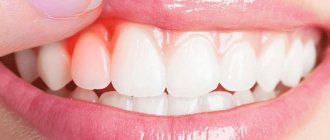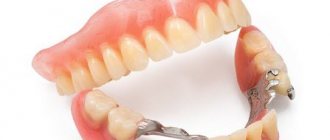Bruxism and hypertonicity of the masticatory muscles are inextricably linked processes. Bruxism is a condition when the muscles of the jaw involuntarily spasm, as a result of which a person begins to grind his teeth. There is an increased tone of the masticatory muscles.
Very often, this problem becomes a serious obstacle to dental procedures, such as implantation, prosthetics, and installation of veneers. Bruxism can interfere with quality orthodontic treatment. Increased tone of the jaw muscles overloads the implants, and dentures are destroyed much faster.
Bruxism also has a negative effect on “native” teeth. The enamel is damaged and worn away, and the teeth become loose. Therefore, if such a problem arises, it is necessary to look for ways to solve it. Thanks to modern medicine, you can get rid of bruxism for a long time.
Symptoms of bruxism and the main causes of hypertonicity:
- the surface of the teeth grinds down, they become flatter;
- the enamel is damaged, fillings fall out, teeth begin to loosen, their integrity is violated, the gums become raw and bleed;
- crunching and clicking appears in the jaw when opening and chewing;
- teeth grinding occurs when a person sleeps;
- it is difficult to open and close your mouth, you feel tired and overstrained masticatory muscles;
- you often unconsciously clench your jaw, most of the time they are tense;
- malocclusions appear;
- the lower part of the face takes on a square shape;
- posture worsens.
Consult an orthodontist
Very often, the main cause of bruxism is a malocclusion. Due to the fact that the teeth do not close correctly, and chewing requires effort, tension accumulates in the masticatory muscles during the day, and then involuntary contractions occur during sleep.
Until bite problems are corrected, treatment will not bring complete recovery. Therefore, consultation with an orthodontist is recommended for bruxism.
If treatment is indicated, the doctor will advise which system is best suited and in what time frame the goal can be achieved.
How is the bite corrected during bruxism?
The main treatment for bruxism in adults is braces. But since this structure is voluminous, the question arises: will the braces be damaged due to such a problem as teeth grinding at night?
If the overlap of the teeth is deep enough, then the system needs to be protected. In this case, overbite fillings are placed on the teeth: they are made from the same material as conventional fillings, but are installed on the enamel without processing it. The fillings are convex, so they prevent the teeth from closing deeply. After treatment, they can be easily removed without damaging the enamel.
Overbite fillings (blue)
Botulinum therapy as a method of treating bruxism
Botulinum therapy is effectively used to relieve overstrain in the masticatory muscles, fights bruxism and can relieve involuntary teeth grinding at night.
In medicine, as in cosmetology, botulinum toxin type A is used. It is able to immobilize a muscle or relieve tension in it, acting locally. This effect lasts only for a certain period of time. But during this time the body manages to get used to the new state, and the overstrain disappears completely.
Botulinum toxin type A is a neurotoxin produced by the bacteria Clostridium botulinum. It is capable of blocking impulses from the central nervous system sent to the muscles. In fact, botulinum toxin paralyzes them, breaking the connection between muscle fibers and the brain.
The drug is injected into the required areas, so it has an effect exclusively on the desired areas. Dosages of butolotoxin are completely safe, and its effect is reversible. After six months, it is completely eliminated from the patient’s tissues.
Chewing muscles - anatomy
Before working with these muscles (and any others), you need to clearly understand their location on the face, shape, size, structure. Good visualization and concentration will improve the effectiveness of our exercises many times over! Therefore, a little anatomy is necessary:
On the left side of the picture, the “Masticator” is a superficial muscle that can be easily felt by placing your palms on it near the corners of the lower jaw and clenching your teeth.
The temporalis muscle is also a masticatory muscle, since its lower process is attached to the lower jaw (more precisely, to the coronoid process), so it also spasms from our habit of clenching our teeth and from stress.
There are also a couple of groups of deep masticatory muscles that for some reason are rarely talked about. Here they are:
1- Lateral masseter muscle, 3- medial masseter muscle.
And as you can see, they are deep - located right inside the skull, so it is quite difficult to relax them. What the tension of these muscles leads to, how it is reflected on the face - I’ll tell you now.
Main stages of treatment
The first step is preparation for the procedure. It's simple. For a few days, it is necessary to eliminate alcoholic beverages from the diet, and also reduce caffeine consumption. Before the procedure, you should not take antibiotics or blood thinners.
The second step is the introduction of butolotoxin. The procedure lasts about twenty minutes. The required dose is divided into three to four injections. The injection needles are very thin, so the procedure is virtually painless.
The third step is the rehabilitation period. Butolotoxin acts instantly, but gains its full strength after two weeks. After injections, it is not recommended to overheat or cool the treated areas. Sports and facial massage should be excluded.
Contraindications
In some cases, it is contraindicated to relax the chewing facial muscles by performing light gymnastic exercises.
It is recommended to refrain from the procedure if:
- allergic reaction in the acute stage;
- inflamed facial nerve;
- high body temperature;
- high blood pressure;
- there are rashes, irritation or acne on the skin;
- fragile blood vessels and pathologies associated with blood clotting;
- sinusitis, rhinitis.
If a sharp pain is felt when performing any exercise, then the complex is performed incorrectly or is contraindicated. It is recommended not to perform it again or to consult with your doctor.
Implantation for bruxism
Implants can be placed if an integrated approach has been taken to the procedure. In cases where the dental system has not worked correctly for a long period of time, dentists perform treatment using complex implantation.
If excessive tension in the jaw muscles was caused by a reason such as psychosomatics, then the patient is referred for examination to a specialized specialist. Only then can you begin to restore your teeth.
Preventing spasms in the jaw muscles
To prevent the occurrence of such symptoms, you need to treat bad teeth in a timely manner and regularly visit the dentist’s office. If possible, avoid jaw injuries and stressful situations and take care of your mental health.
READ ALSO: how can you straighten your jaw if it is dislocated?
Often, dehydration can provoke a spasm of the masticatory apparatus, so you need to drink more, consuming at least 1.5 liters of fluid per day. By eating right and leading a healthy lifestyle, you can strengthen your muscles and improve your body's immune system.
Prevention of bruxism
Preventive measures for hypertonicity of the masticatory muscles of the jaw imply measures that can prevent bruxism. Treatment of this disease without diagnosis and examination by a qualified specialist can be hazardous to health. As soon as you notice the first signs of this pathology, you need to consult a doctor as soon as possible. He will prescribe diagnostics that will help identify a possible problem and effectively eliminate it.
The patient may need to be examined by specialists such as a neurologist or psychotherapist. Increased tone of the masticatory muscles has different etiologies. Doctors in these areas can prescribe various treatments, such as physical therapy, magnesium-based medications. All this is decided on an individual basis.
Preventative measures may help if approved by the patient's physician. You can easily massage the cramped areas. There is a set of exercises that can reduce the manifestations of bruxism. They must be done daily before going to bed.
Stressful situations must be avoided. You should rest more, get enough sleep, and spend a lot of time outdoors. Avoid caffeine and take baths with herbs that have a sedative effect. These measures will be an excellent prevention of muscle spasms, and will also enhance the effect of complex treatment.
Contact the Denta-Labor dental laboratory for solutions to issues regarding the protection of your teeth during bruxism.
Tension of the masticatory muscles - how it manifests itself with age
Let's start with the deep (medial and lateral) muscles. The medial one (No. 3 in the picture) is responsible for the movement of the jaw to the right and left. Have you noticed that some older (and not so old) women have an asymmetrical jaw - larger on one side and smaller on the other? This just indicates a spasm of this muscle on one side. Therefore, in order to have a symmetrical face without distortions, it must be relaxed.
The lateral (No. 1) masseter muscle pushes the lower jaw forward and pushes it back. It greatly affects the bite. I think everyone has seen this in others or maybe in themselves:
Here is a clear example of excessive tension in the lateral masticatory muscles - they literally pull the lower jaw inward.
But there is also the opposite situation - when the muscles are too weak, in hypotonicity:
The lower jaw then moves forward. Of course, now this is corrected with braces. However, with the help of exercises this can be done without them. And if you already wear braces, you can significantly speed up the results with exercises. This is confirmed by orthodontists.
Spasms of the temporal muscles lead to the fact that the eyebrows begin to float down and the face becomes gloomy. The habit of clenching your teeth (mostly unconsciously, from stress, anger, irritation) causes tension in the facial muscles of mastication - those at the corners of the jaw. This causes the oval of the face to float; the face may even become longer with age. Bruxism may develop, tooth decay may begin, and gum disease may appear - because chronic spasm of these muscles blocks normal blood circulation.
3 more exercises
- The “Pressing” exercise can strengthen the muscular corset of the tongue. You need to forcefully press it to the sky. Next, you should stay in this position for 10-15 seconds. Then, again with effort, pull your tongue towards the larynx. And again remain in the accepted position for 10 seconds. Next, press firmly with your tongue on the dental crowns of the upper row. Stay in this position for 10-12 seconds. There should be 3 approaches. Breathe through your nose and close your lips tightly.
- An equally productive exercise is “Show off your tongue.” We need to show it as much as possible. Try to reach it first to the edge of your nose, and then to your chin. There must be at least 20 approaches.
- The “Tongue Candle” exercise will also help. It is done very simply. You should open your mouth, just forcefully, to feel a slight stretch. Now try to reach the upper palate with your tongue. In this position, the hyoid part is quite tense. There are 10 approaches as usual. It is more productive to perform this task with your head tilted up.










